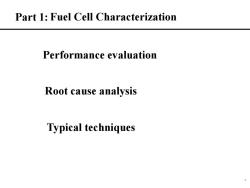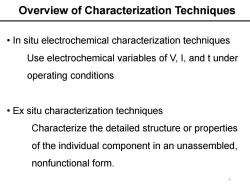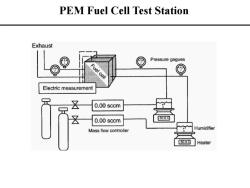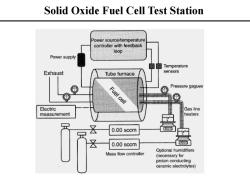电子科技大学:《物理与化学电源基础 Fundamental of Physical and Chemical Power Sources》课程教学资源(课件讲稿,第一部分)Section IV THERMODYNAMICS

THERMODYNAMICS Thermodynamics is the study of energetics,focusing on the transformation of energy from one form to another.Since fuel cells are energy conversion devices,thermodynamics is key to understand the conversion of chemical energy into electrical energy. For fuel cells: >thermodynamics can predict whether a candidate fuel cell reaction is energetically spontaneous, >thermodynamics places upper bound limits on the maximum electrical potential that can be generated in a reaction
THERMODYNAMICS Thermodynamics is the study of energetics, focusing on the transformation of energy from one form to another. Since fuel cells are energy conversion devices, thermodynamics is key to understand the conversion of chemical energy into electrical energy. For fuel cells: thermodynamics can predict whether a candidate fuel cell reaction is energetically spontaneous, thermodynamics places upper bound limits on the maximum electrical potential that can be generated in a reaction

THERMODYNAMICS Part 1:Fuel Cell Characterization Part 2:Fuel Cell Voltage Part 3:Fuel Cell Efficiency Part 4:Butler-Volmer Equation Part 5:Electrical Conduction Part 6:Charge transport Part 7:Mass Transport
Part 1: Fuel Cell Characterization Part 2: Fuel Cell Voltage Part 3: Fuel Cell Efficiency Part 4: Butler-Volmer Equation Part 5: Electrical Conduction Part 6: Charge transport Part 7: Mass Transport THERMODYNAMICS

Part 1:Fuel Cell Characterization Performance evaluation Root cause analysis Typical techniques
4 Fuel Cell Characterization Typical techniques Performance evaluation Root cause analysis Part 1:

What Do We Want to Characterize? Overall performance (j-V curve,power density) Kinetic properties (nact,jo) Ohmic properties (Rohmic) Mass transport properties (jL,Def) Electrode structure (porosity,tortuosity) Lifetime issues (degradation,cycling,start up/ shut down,load following) 5
5 What Do We Want to Characterize? • Overall performance (j-V curve, power density) • Kinetic properties (hact, jo ) • Ohmic properties (Rohmic) • Mass transport properties (jL , Deff) • Electrode structure (porosity, tortuosity) • Lifetime issues (degradation, cycling, start up/ shut down, load following)

Overview of Characterization Techniques In situ electrochemical characterization techniques Use electrochemical variables of V.I,and t under operating conditions Ex situ characterization techniques Characterize the detailed structure or properties of the individual component in an unassembled, nonfunctional form. 6
6 Overview of Characterization Techniques • In situ electrochemical characterization techniques Use electrochemical variables of V, I, and t under operating conditions • Ex situ characterization techniques Characterize the detailed structure or properties of the individual component in an unassembled, nonfunctional form

In Situ Electrochemical Characterization Current-voltage (J-V)measurement Current interruption measurement Electrochemical impedance spectroscopy ·Cycling testing Steady-state testing
7 In Situ Electrochemical Characterization • Current-voltage (J-V) measurement • Current interruption measurement • Electrochemical impedance spectroscopy • Cycling testing • Steady-state testing

PEM Fuel Cell Test Station Exhaust Pressure gagues Fuel cell Electric measurement 0.00 sccm 0.00 sccm 500g Mass flow controller Humidifier 500C Heater
PEM Fuel Cell Test Station

PEM Fuel Cell Test Station 配 8 相Qe代但a 9
PEM Fuel Cell Test Station

Solid Oxide Fuel Cell Test Station Power source/temperature controller with feedback loop Power supply Temperature Exhaust Tube furnace sensors Pressure gagues Fuel cell Electric Gas line measurement heaters 0.00 sccm 0.00 sccm Optional humidifiers Mass flow controller (necessary for proton conducting ceramic electrolytes)
Solid Oxide Fuel Cell Test Station

Solid Oxide Fuel Cell Test Station
Solid Oxide Fuel Cell Test Station
按次数下载不扣除下载券;
注册用户24小时内重复下载只扣除一次;
顺序:VIP每日次数-->可用次数-->下载券;
- 电子科技大学:《物理与化学电源基础 Fundamental of Physical and Chemical Power Sources》课程教学资源(课件讲稿,第一部分)Section III Fundamentals of Solar Cell.pdf
- 电子科技大学:《物理与化学电源基础 Fundamental of Physical and Chemical Power Sources》课程教学资源(课件讲稿,第一部分)Section II Nuclear energy(Fundamentals of Fusion Enery).pdf
- 电子科技大学:《物理与化学电源基础 Fundamental of Physical and Chemical Power Sources》课程教学资源(课件讲稿,第一部分)Section I Background and Fuel Cell(陈俊松).pdf
- 电子科技大学:《物理与化学电源基础 Fundamental of Physical and Chemical Power Sources》课程教学资源(课件讲稿,第二部分)Lecture 07 Anode material for LIBs(Lithium).pdf
- 电子科技大学:《物理与化学电源基础 Fundamental of Physical and Chemical Power Sources》课程教学资源(课件讲稿,第二部分)Lecture 06 Anode material for LIBs(Graphite).pdf
- 电子科技大学:《物理与化学电源基础 Fundamental of Physical and Chemical Power Sources》课程教学资源(课件讲稿,第二部分)Lecture 05 Cathode material for LIBs(Li-Mn-O and NCM).pdf
- 电子科技大学:《物理与化学电源基础 Fundamental of Physical and Chemical Power Sources》课程教学资源(课件讲稿,第二部分)Lecture 04 Cathode material for LIBs(LiFePO4).pdf
- 电子科技大学:《物理与化学电源基础 Fundamental of Physical and Chemical Power Sources》课程教学资源(课件讲稿,第二部分)Lecture 03 Lithium-ion Batteries(LiCoO).pdf
- 电子科技大学:《物理与化学电源基础 Fundamental of Physical and Chemical Power Sources》课程教学资源(课件讲稿,第二部分)Lecture 02 Introduction of Lithium Batteries.pdf
- 电子科技大学:《物理与化学电源基础 Fundamental of Physical and Chemical Power Sources》课程教学资源(课件讲稿,第二部分)Lecture 01 Background of Batteries(陈俊松).pdf
- “十四五”可再生能源发展规划(发布稿).pdf
- 《电力系统运行与控制 Power System Operation and Control》课程参考书籍文献:《Operation and Control in Power Systems》PDF电子书(Prof. P. S. R. MURTY).pdf
- 电子科技大学:《电力系统运行与控制 Power System Operation and Control》课程教学资源(课件讲稿)Lecture 10 Power System Security.pdf
- 电子科技大学:《电力系统运行与控制 Power System Operation and Control》课程教学资源(课件讲稿)Lecture 09 Power System Optimal Power Flow.pdf
- 电子科技大学:《电力系统运行与控制 Power System Operation and Control》课程教学资源(课件讲稿)Lecture 08 power system state estimation.pdf
- 电子科技大学:《电力系统运行与控制 Power System Operation and Control》课程教学资源(课件讲稿)Lecture 07 Power System Wide-area Measurement and Control.pdf
- 电子科技大学:《电力系统运行与控制 Power System Operation and Control》课程教学资源(课件讲稿)Lecture 06 Power System Reactive Power and Voltage Control.pdf
- 电子科技大学:《电力系统运行与控制 Power System Operation and Control》课程教学资源(课件讲稿)Lecture 05 Power Generation Control and Frequency Regulation.pdf
- 电子科技大学:《电力系统运行与控制 Power System Operation and Control》课程教学资源(课件讲稿)Lecture 04 Unit Commitment in Power System.pdf
- 电子科技大学:《电力系统运行与控制 Power System Operation and Control》课程教学资源(课件讲稿)Lecture 03 Power System Economic Dispatch.pdf
- 电子科技大学:《物理与化学电源基础 Fundamental of Physical and Chemical Power Sources》课程教学资源(课件讲稿,第二部分)Lecture 10 Anode material for LIB(TiO2).pdf
- 电子科技大学:《物理与化学电源基础 Fundamental of Physical and Chemical Power Sources》课程教学资源(课件讲稿,第二部分)Lecture 11 Safety of Li-ion Batteries.pdf
- 电子科技大学:《物理与化学电源基础 Fundamental of Physical and Chemical Power Sources》课程教学资源(课件讲稿,第二部分)Lecture 12 Solid-state Electrolyte in Li-ion Batteries(SSE of LIB).pdf
- 电子科技大学:《物理与化学电源基础 Fundamental of Physical and Chemical Power Sources》课程教学资源(课件讲稿,第二部分)Lecture 08 Anode Material for LIBs(Silicon).pdf
- 电子科技大学:《物理与化学电源基础 Fundamental of Physical and Chemical Power Sources》课程教学资源(课件讲稿,第二部分)Lecture 09 Anode material for LIBs(Tin).pdf
- 《电力系统自动化》:利用储能系统提升电网电能质量研究综述.pdf
- 《电力电子技术 Power Electronics》:电能质量指标及其算法的研究.pdf
- 深圳市标准化指导性技术文件:分布式光伏发电系统并网接入技术规范(SZDB/Z 227 - 2017)Technical specification for distributed photovoltaic generation system Grid-connected.pdf
- 智能电网:改善低压农网电压质量的分布式光伏——储能系统优化配置方法.pdf
- 国投甘肃小三峡发电有限公司:浅析水电厂AVC控制策略.pdf
- 中国电机工程学会:核能发电专业发展报告(PPT宣讲稿,2019年11月).pdf
- 山西能源学院:《传热学》课程教学资源(电子教案)第一章 绪论 1.1 传热学的研究内容及其在科学技术和工程中的应用 1.2 热能传递的三种基本方式.pdf
- 山西能源学院:《传热学》课程教学资源(电子教案)第二章 稳态热传导 2.1 导热基本定律-傅里叶定律.pdf
- 山西能源学院:《传热学》课程教学资源(电子教案)第二讲 第一章 绪论 1.3 传热过程和传热系数 1.4 传热学的发展简史和研究方法.pdf
- 山西能源学院:《传热学》课程教学资源(电子教案)第二章 稳态热传导 2.2 导热问题的数学描写 2.3 典型一维导热问题的分析解-通过平壁的导热.pdf
- 山西能源学院:《传热学》课程教学资源(电子教案)第二章 稳态热传导 2.3 典型一维导热问题的分析解-通过圆筒壁的导热 2.4 通过肋片的导热.pdf
- 山西能源学院:《传热学》课程教学资源(电子教案)第三章 非稳态热传导 3.1 非稳态导热的基本概念.pdf
- 山西能源学院:《传热学》课程教学资源(电子教案)第三章 非稳态热传导 3.2 零维问题的分析法-集中参数法.pdf
- 山西能源学院:《传热学》课程教学资源(电子教案)第四章 热传导问题的数值解法 4.1 导热问题数值求解的基本思想 4.2 内节点离散方程的建立方法.pdf
- 山西能源学院:《传热学》课程教学资源(电子教案)第三章 非稳态热传导 3.3 典型一维非稳态导热的分析解.pdf
